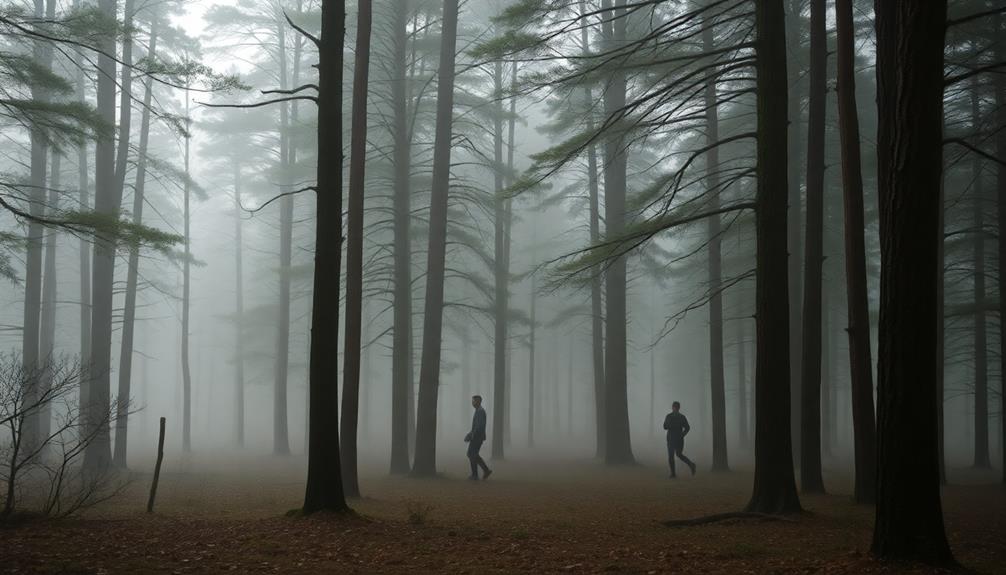Carbon dioxide, or CO2, is usually odorless in normal conditions, so you won't smell it easily. However, if it builds up in high concentrations, some people might detect a faint, pungent scent or sense a biting taste. This can happen in enclosed spaces like basements or poorly ventilated areas. It's important to monitor CO2 levels since high amounts can cause headaches or dizziness. Regular ventilation and using CO detectors can keep you safe. Isn't it fascinating how something we can't smell can impact our health? Stick around, and you'll discover more about CO2 and its significance!
Key Takeaways
- Carbon dioxide (CO2) is generally considered odorless under normal conditions.
- At high concentrations, CO2 may produce a slight pungent odor or biting taste.
- CO2 is colorless and non-flammable, making it hard to detect without monitoring.
- Symptoms like headaches and dizziness can indicate high CO2 levels in enclosed spaces.
- Proper ventilation and monitoring are essential for safety in areas with potential CO2 buildup.
Introduction

When you think about carbon dioxide (CO2), you might assume it has a smell, but surprisingly, it's generally considered odorless. This means that under normal conditions, you won't detect any scent when CO2 is present.
However, in high concentrations, some people might notice a slight pungent odor or biting taste, but this isn't something everyone experiences.
CO2 is heavier than air, so it can gather in low-lying areas, which can lead to increased concentrations without any noticeable smell. This makes it tricky because, unlike many other gases that you can sense by their odor, CO2 is hard to detect.
That's why it's crucial to monitor levels, especially in enclosed areas like basements or poorly ventilated rooms.
If CO2 builds up to high levels, it can cause symptoms such as headaches and dizziness.
But remember, these symptoms aren't linked to any smell, since CO2 itself doesn't carry a strong odor.
It's important to stay aware of your environment and take precautions to ensure safe air quality.
Description of the Smell

While most people might expect a gas like carbon dioxide (CO2) to have a distinctive odor, it's actually odorless under normal conditions. This means you won't catch a whiff of it in the air like you'd with other gases. However, in high concentrations, some individuals might notice a slight pungent odor and even a biting taste. This can be surprising because CO2 is colorless and non-flammable, making it hard to detect.
Since carbon dioxide doesn't have a detectable smell, it can pose health risks if levels rise too high. You can't rely on your nose to sense its presence, so using proper monitoring equipment is essential. These devices will alert you if CO2 levels become dangerous, ensuring your safety.
In everyday situations, like parties or gatherings, you can breathe easy knowing that CO2 is usually present in safe amounts. Just remember, if you ever feel a little dizzy or lightheaded in a closed space, it might be a good idea to check those levels!
Understanding that CO2 is odorless helps keep you informed and safe in various environments.
Source and Composition

On the flip side, human activities contribute significantly to CO2 levels in the atmosphere. Burning fossil fuels for energy and transportation releases large amounts of this gas.
Industrial processes, like cement production, also add to the carbon footprint we create.
Interestingly, CO2 is soluble in water, leading to the formation of carbonic acid. This is what gives your favorite carbonated beverages their slight acidity.
So, whether it's from a breath of fresh air or the fizz in your soda, carbon dioxide is all around you.
Understanding its sources and composition helps you appreciate the delicate balance of our planet's atmosphere!
Typical Scenarios or Environments

Understanding the sources and composition of carbon dioxide (CO2) leads us to recognize where it most commonly accumulates.
You'll often find CO2 in confined spaces, like basements or cellars, where it can gather in high levels. This gas is naturally produced during processes like fermentation or even volcanic eruptions, but it doesn't have a smell that you can detect.
In poorly ventilated areas, the density of CO2 makes it settle lower in the space, which increases the risk of discomfort. Symptoms include shortness of breath or a slight pungent taste, which may feel like an odor but isn't. If CO2 levels rise too high, it can even lead to a loss of consciousness.
That's why it's crucial to ensure good airflow, especially in places where you might spend a lot of time.
Always be aware of your surroundings. If you start feeling dizzy or lightheaded in a confined area, it's a good idea to get some fresh air.
Staying safe means understanding where CO2 can build up and knowing the signs to watch for.
Emotional or Cultural Associations

Many people mightn't realize that carbon dioxide (CO2), often deemed odorless, can evoke a variety of emotional responses and cultural associations. While CO2 is typically insensitive to our noses, some might catch a slight pungent odor, especially in stuffy places. This can lead to feelings of discomfort about air quality. You might even feel a bit anxious, as high levels of CO2 can remind you of asphyxiation and its dangers.
Culturally, CO2 represents more than just an invisible gas. Many folks associate it with urgent issues like climate change and air pollution, sparking concern and a desire for action.
On a lighter note, think about carbonated drinks. The fizz from CO2 can create joyful moments, bringing refreshment and happiness to gatherings.
In art and literature, CO2 often symbolizes deeper emotional struggles, like suffocation or feeling trapped.
Whether you're enjoying a fizzy soda or contemplating environmental challenges, CO2 holds different meanings. It's fascinating how a simple gas can connect us to a wide array of feelings and cultural ideas!
Health or Safety Considerations

To stay safe, it's important to use a CO detector in areas where CO2 is likely to accumulate.
Additionally, air purifiers with effective filtration can help improve air quality and reduce pollutants in your environment.
Also, ensure that there's proper ventilation. This means keeping windows open or using fans to help air circulate.
Regularly check your ventilation systems to keep air fresh and reduce CO2 buildup.
Remember, monitoring your environment can help you avoid health risks.
So, don't overlook the importance of fresh air!
Final Thoughts

When it comes to carbon dioxide, being aware of its odorless nature is crucial for your safety. Since CO2 is generally odorless, you can't rely on your nose to detect it. This makes using carbon dioxide detectors essential, especially in enclosed spaces where CO2 can accumulate and lead to asphyxiation.
Remember, this gas is heavier than air, so it tends to settle in low-lying areas, which could be dangerous if there's poor ventilation.
Although some people might notice a slight pungent odor at high concentrations, this isn't the case for everyone. That's why you shouldn't wait for a smell to take action.
Regularly check your ventilation systems and ensure they're functioning properly, as these systems help maintain air quality and prevent dangerous buildup.
Frequently Asked Questions
Does Carbon Dioxide Have a Smell?
You might wonder if carbon dioxide has a smell. It doesn't; it's colorless and odorless under normal conditions. In high concentrations, some may sense a faint odor, but it's not commonly recognized. Even though carbon dioxide itself doesn’t have a distinct odor, some people may associate it with what coke smells like due to the carbonation present in soft drinks. However, it’s actually the other compounds in the beverage that produce the familiar scent. The gas itself remains undetectable by smell under normal conditions.
What Does a Carbon Dioxide Leak Smell Like?
You won't smell a carbon dioxide leak because it's generally odorless. If you notice symptoms like headaches or dizziness, it's crucial to evacuate the area, as elevated CO2 levels can be dangerous and undetectable.
Does Carbon Dioxide Have a Pungent Smell?
You might think carbon dioxide has a pungent smell, but it's generally odorless. If you notice a scent, it's likely due to other substances in the environment rather than CO2 itself. Stay cautious!
Can You Smell Carbon Dioxide in Your Home?
You can't smell carbon dioxide in your home since it's odorless. However, high levels can cause symptoms like headaches or dizziness. It's crucial to monitor CO2 levels with a detector for safety.









